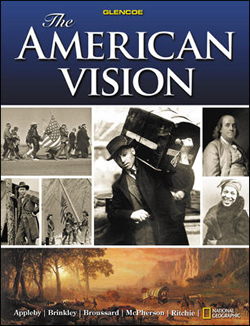
The American Vision © 2008Chapter 6: The Spirit of ReformChapter OverviewsThis chapter focuses on how significant political, cultural, and spiritual changes of the early 1800s impacted American society. Section 1 discusses how the election of Andrew Jackson ushered in a new era of American politics. Jackson's humble roots and western style helped him win the presidential election in 1828. Shunning the political elite, Andrew Jackson instituted government reforms that he believed would put political power in the hands of ordinary citizens. During his first term, disputes between the North and the South erupted in a crisis over states' rights. Compromise ended the crisis, but the debate over states' rights was far from over. Jackson's forceful style showed in his heavy-handed policies toward Native Americans and his opposition to the Second Bank of the United States. Not all Americans thought that Jackson's ideas were best for the nation. By the mid-1830s the Whig Party emerged, advocating a larger federal government and support for industry. The Whigs had their chance in the White House after the 1840 presidential election, but on key issues President John Tyler acted more like a Democrat. Section 2 describes how the United States underwent dramatic cultural changes during the early and mid-1800s. While millions of immigrants were arriving to pursue America's promises of freedom and opportunity, protestant ministers were leading a nationwide religious revival. The Second Great Awakening preached the message that anything was possible with hard work and prayer. The immigrants' hopes and the revival's message combined to reinforce the belief that people had the ability to redefine their lives. Ideas such as romanticism and transcendentalism influenced writers, artists, and philosophers. American writers such as Ralph Waldo Emerson and Henry David Thoreau promoted the individual over society and feelings over reason. The importance of inner spirituality sparked new religious groups such as unitarians and mormons and inspired new communities. Tolerance was not always practiced in the new American society, however, as some groups faced harassment and discrimination. Section 3 explores the American reform movement of the early and mid-1800s. The religious revivalism that swept the country at that time inspired a national reform movement. Benevolent societies sprang up to spread the word of God and combat the ills of society. Reformers in the temperance movement encouraged moderation in the consumption of alcohol. Prison reform focused on improving conditions for inmates and rehabilitating prisoners. Believing that well-educated societies made better nations, reformers in the education movement pushed for government-funded schools. Women's opportunities for education improved as well. In magazines and books, popular culture promoted the idea that "true womanhood" required that women take responsibility for their families' moral character. As women began expanding their roles to address problems of society, they found they needed greater political rights to promote their ideas. Section 4 details the early years of the most divisive of all reform movements—the abolitionist movement. Early antislavery societies opposed slavery because they thought it was morally wrong. They advocated gradualism and colonization as appropriate solutions to the slavery issue. After the 1830s abolition started to gain support. Abolitionists, such as William Lloyd Garrison, argued for the immediate emancipation of enslaved African Americans. Garrison used his newspaper to attack slavery, and he and his followers established antislavery societies. Freed African Americans used their slave experience to take prominent roles in the abolitionist movement. Abolitionists such as Frederick Douglass and Sojourner Truth described the horrors of slavery with compelling eloquence. The Northern response to abolition ranged from support to opposition. Southern leaders, however, rushed to defend slavery—the institution that was the foundation of their economy. |  |















